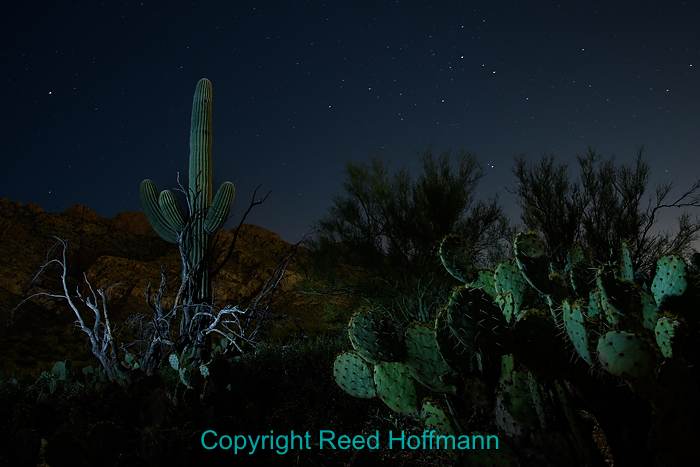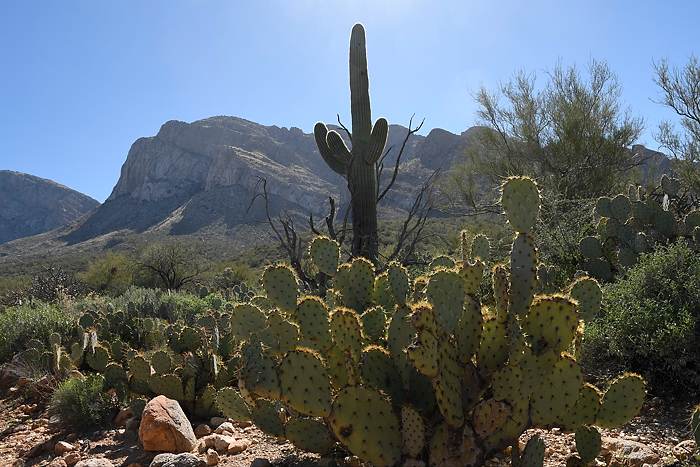I’m teaching a workshop for Best Buy this week in Tucson, and wanted to take advantage of being in the desert. So last night I took a stroll out among the cactus to do some light painting. Here are the steps I go through when doing that:
1 – First, I found a scene I liked (in the daytime, when it’s easier to see what’s there), then returned at night and set up my tripod. That’s the photo shown here, though you’ll see I chose a different angle for the night shot.
2 – I need a fairly long time exposure so I have enough time to move around and “paint” light on the areas with my flashlight. That means I set my camera on Manual exposure and usually start with around 20-seconds. Then I use ISO and aperture to find an exposure that shows the sky and surrounding area the way I want it to look.
3 – After that I set the self-timer, usually for ten seconds (although I might use 20-seconds if I need more time to move away from the camera). My Nikon camera also allows me to set it to shoot more than one frame while using the self-timer. I’ll take advantage of that so I don’t have to come back to the camera between each shot. In this case I had it shoot two frames. So after the count-down of the timer, the camera opens the shutter for the exposure. At the end of that exposure, it closes the shutter, and after three-seconds opens it again for a second shot.
4 – Now I trip the shutter and the self-timer starts its count-down, and I move to where I’m going to start painting. I can usually hear when the camera fires, and then I start painting. The trick here is two-fold. One, to light only a few areas. You normally don’t want to light everything. And two, to keep the light to the side or behind, not have the light coming from the same angle the camera is. That would result in flat light, and be less interesting. In this case there were three primary areas I lit, all from the left side. First was the cactus in the foreground, and I was about ten feet to the left for that. Then I moved further away to the left, and lit the saguaro cactus. And finally, I lit the dead tree and smaller cactus at the base of the saguaro.

The light in the sky at far right is from Tucson. With this exposure you can see the stars, and some color in the sky. But without light, the cactus would be either too dark to see, or just silhouettes against the sky. The light on the mountains in the background is from the moon. Nikon D500, ISO 200, 30-seconds at f/4.5, Nikkor 16-80mm f/2.8-4 lens at 24mm. Photo copyright Reed Hoffmann.
I spent about 90-minutes making three different photos out there. Light painting takes time, and is all about trial and error. You’ll never get the same look twice, and while that can be frustrating at times, it’s also part of the fun. I compare light painting to what happened when we printed photos in darkrooms. If you’re doing any burning or dodging, you’ll never get the exact same print twice.
Light painting’s a lot of fun, so I try to do it any time I’ve got a good opportunity. It just means I need to have a tripod, a flashlight to paint with (and I’ve used smartphones as a light) and a flashlight or headlamp to see where I’m going (which again, can be a smartphone).
If you’re in Kansas City, you can come and hear me give a talk about light painting at Digital Dimensions, a local club, on March 16. If not, you can teach yourself. You just need those few tools and a willingness to play. Have fun!
(If you like this story, please share it with your friends, and let them know about the links on photography I post on my business Facebook page. I’m also on Instagram @reedhoffmann)

